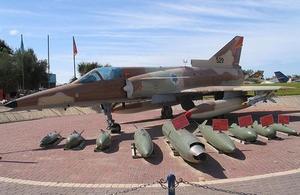SyriaIsraeli jets attack Syrian weapons convoys in Hezbollah-held area in Lebanon
For the second time this year. Israeli jets attacked targets on the border between Lebanon and Syria on Monday night as part of an ongoing campaign to prevent the transfer of advanced weapon systems from the Syrian military to Hezbollah. In 2013, the Israel Air Force (IAF) attacked military bases and arms depots inside Syria on six occasions — 30 January, 3 May, 5 May, 5 July, 18 October, and 30 October. The first attack in 2014 took place on 26 January. The previous seven air strikes were on targets inside Syria, but last Sunday attack was on Syrian military convoys just inside Lebanon, in Hezbollah-controlled areas near the Lebanon-Syria border.

An Israeli Kfir C2 fighter-bomber displayed with ordinance // Source: commons.wikimedia.org
For the second time this year. Israeli jets attacked targets on the border between Lebanon and Syria on Monday night as part of an ongoing campaign to prevent the transfer of advanced weapon systems from the Syrian military to Hezbollah.
In 2013, the Israel Air Force (IAF) attacked military convoys and arms depots inside Syria on six occasions — 30 January, 3 May, 5 May, 5 July, 18 October, and 30 October. The first attack in 2014 took place on 26 January.
The previous seven air strikes were on military bases and arms depots inside Syria, but last Sunday attack was on a Syrian mlitary convoy just inside Lebanon, in Hezbollah-controlled areas near the Lebanon-Syria border.
Haaretz reports that earlier today (Tuesday), during a joint cabinet meeting between Israel and a German delegation headed by Chancellor Angela Merkel, Prime Minister Benjamin Netanyahu indirectly commented on the air strike, but without giving any details: “I am not speaking about claims that have been made about what we did or didn’t do. Our policy is clear — we do what we have to in order to secure Israel.”
Al Arabiya News TV reported that a number of Hezbollah members were killed in the raid, a claim denied by Hezbollah’s Al Manar TV.
According to the Lebanese newspaper Daily Star, the 10:30 p.m., Monday attack destroyed vehicles and targets in the Janta and Nabi Sheet areas in the Bekaa Valley where Hezbollah has several training and recruitment facilities, and which are known smuggling routes for arms between Syria and Lebanon.
Israel has made public its determination to prevent Syria from transferring to Hezbollah three advanced weapon systems – long-range anti-ship “Yakhont” missiles, SI-17 advanced anti-aircraft missiles, and precise mid-range Fateh-110 rockets.
The seven attacks Israel has so far launched on targets inside Syria, and the recent one inside Lebanon, were all aimed to destroy these system en route to Hezbollah.
President Bashar Assad has become dependent on assistance from Iran and Hezbollah in his fight with the Syrian rebels, and thus in no position to reject pressure from these two allies to transfer advanced systems to Hezbollah. Haaretz notes various intelligence sources believe that Israeli air strikes notwithstanding, Assad has managed to deliver large quantities of advanced weaponry to Hezbollah.
Assad and Hezbollah have so far refrained from responding to the Israeli attacks, for which Israel has not taken official responsibility. Assad knows that if he attacks Israel, the IDF will finish him off and put an end to his regime. Hezbollah’s position in Lebanon has been weakened considerably as a result of the organization’s deep involvement in Syria, and the organization, now in battle against Sunni militias both inside and outside Lebanon, does not appear eager to take on Israel.
